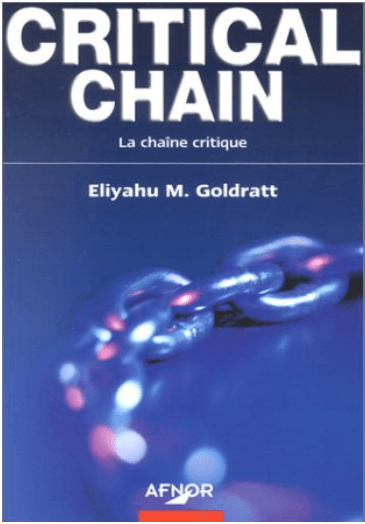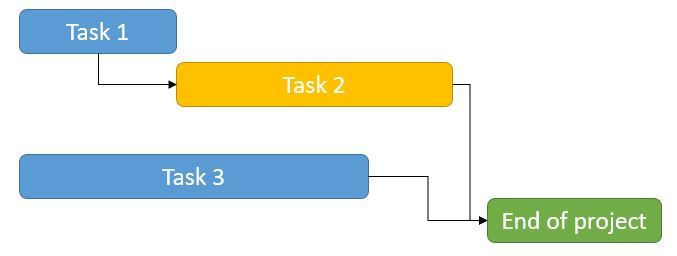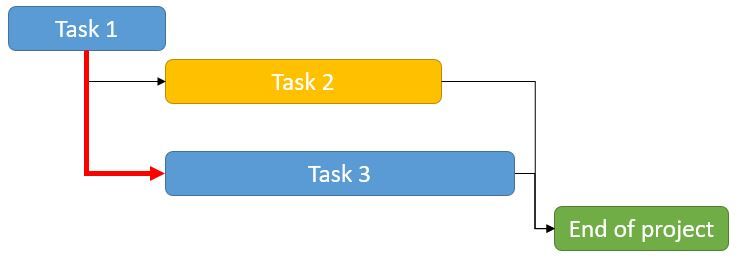Manage projects
with the Critical Chain
- Home >
- The Method
The Critical Chain Project Management

An alternative to classic project planning issues.
Project management is now very common, and planning is an essential component. However, many companies have given up project scheduling, task networks and critical path analysis in favor of high level plans made in Excel or PowerPoint.
Schedules, when they exist, are difficult to follow since they are often too macroscopic and static. Despite the accumulation of experience in project management, we note the persistence of time and budget overruns.
The “traditional” method of the critical path cannot guarantee the conformity of the project with the commitments made.
The most frequently encountered problems in project management are:
- Projects rarely end on the date originally planned,
- Resources are not available at the right time,
- Budgets are often greatly exceeded,
- Features are abandoned or degraded…
An alternative to these issues is the innovative approach of Critical Chain Project Management. This method is derived from the Theory of Constraints which was popularized by the best-selling business novel: The Goal, written by Eliyahu Goldratt.
15 years after The Goal, Eliyahu Goldratt wrote Critical Chain, another novel presenting the application of the Theory of Constraints to project management...


The difficulty of estimating task durations in a project
To respect the overall deadline of a project, the project managers, or the hierarchy, insist on the fact that each task must meet the dates commited to in the initial schedule. The assumption is that if everyone finishes its tasks on time, then the project will finish on time.
Consequently, facing uncertainty and overloads but eager to respect commitments, each task manager negociates the duration of his assigned tasks with a safety margin.
In the end, how long does it really take to complete a task?

Usually, the Critical Path schedules are built with pessimistic estimates (based on the worst experience, taking into account usual problems like overloads, unclear scope, multitasking, etc...). The Critical Chain method (CCPM) challenges this paradigma and asks for optimistic estimates often called "focused" task durations, (similar to the median duration mentioned by the Project Management Institute).
It is however delicate to ask people for a focused duration without the Management's guarantee that they will not be judged on their ability to meet each and every task deadline. Only the Project end date matters.
The Critical Chain should enable to re-establish a relationship of trust between resources, project managers and managers regarding the deadlines.
The first change proposed by the Critical Chain method is to estimate focused durations, also recommended by the PMI.

What is planning with the Critical Chain method?
The Critical Path is described as the longest sequence of tasks that determines the duration of the project.
This definition is only true when the resources are infinite. However, today, the limited number of resources is a major problem for businesses. It seems irrelevant to plan a project as if we had unlimited resources.
The Critical Chain method addresses the resource capacity issue. The Critical Chain is defined as the longest path of dependencies between tasks, taking into account both the logical dependencies between the tasks and the dependencies between the resources. The Critical Chain scheduling method consists in listing the resources that are needed on tasks, to then manage their availability when needed. Synchronizing people is key for shorter project durations.

Usually when schedules exist in a company, the necessary resources are rarely identified on tasks.
The critical chain is the longest chain of tasks taking into account:
-
Logical or structural dependencies between tasks: these dependencies are also taken into account in the calculation of the critical path. These are the predecessor - successor links showing the dependencies between the activities (e.g. before building the walls, the foundations must be in place).
-
Resource dependencies: these dependencies are only taken into account in the calculation of the Critical Chain. A resource cannot focus on several tasks at the same time, it can only carry out one task at a time. This point will be detailed later since it is used in the calculation of the critical chain.
To define the critical chain of a project, it is necessary to list the resources needed and their capacity.

How to take into account the resource capacity?
Most of planning tools can take into account the resource capacity. This action is called leveling.
In a schedule, leveling consists in delaying the start of a task until the resource necessary to carry it out is available.
Leveling tasks in a schedule results in shifting tasks according to implicit resource links, to avoid scheduling two tasks in parallel for the same resource.
With unlimited resources, there is no need for leveling and the Critical Path is therefore equivalent to the Critical Chain. Reality shows us that it is utopian to create schedules with unlimited resources. The Critical Chain method takes into account resource limitations, and puts forward how important resource availability is for project durations.

In the example below, the blue resource must perform tasks 1 and 3. However, these tasks are scheduled at the same time; the blue resource cannot therefore carry out the project as planned below:

Leveling consists in delaying one of the resource's tasks, as if there were a dependency link between tasks 1 and 3, because the blue resource does not have enough time for 2 tasks at a time:

The Critical Chain is the longest path of tasks. It is the constraint of the project, it determines its duration.

How to protect the end date of the project?
The task durations estimated in the CCPM schedule are "focused" durations, they are ambitious estimates. Besides, resource needs are taken into account to foster synchronisation and avoid wainting times. However, these elements do not yet guarantee compliance with the project deadline.
To protect the project's commitment date against contingencies, the CCPM method adds a project buffer at the end of the project. In fact, it is just additional time at the end of the project.
As a consequence, though the task durations in the schedule have shorter durations (focused durations), the end date of the project can be met. Of course, the buffer will be consumed depending on the problems occurring during the project.
Critical Path Project management is a static and deterministic planning of the project, whereas the Critical Chain is a dynamic method taking into account uncertainty. Indeed, with the Critical Chain approach, we accept that the tasks' estimated start and end dates will change as the situation evolves: it is not a problem as long as we have enough remaining buffer.
The project's commited end date is of course the project buffer end date (the buffer is not an option).

Management usually understands very well the need for a buffer to set deadlines when focused durations are used in the schedules. If the calculated project end date is earlier than the project end date expected by the management team, then the start date of the project could be postponed (so investments are delayed), or this “time advantage” could be exploited (for instance to launch a product earlier on the market).
In the event of a project end date which is too late compared to what is needed, there are two solutions:
-
To optimize the schedule by reducing the Critical Chain length, thanks to additional resources for example,
-
To renegotiate the project end date with the client based on the Critical Chain schedule.
One of the advantages of the Critical Chain planning compared to "traditionnal" planning is that it is shared and approved by the whole team. Without this team cohesion, efforts to reach the goal will be diminished. The objectives are achievable and everyone believes in them, which reinforces alignment within the project team and with management.
The priority is to focus on the critical chain. So at any moment, there is only one place, one task, and often only one priority resource.

When the project goes from planning to execution, it is important to challenge resources not on task end dates but on task durations. The Critical Chain must be considered as a relay race. This means that resources on the Critical Chain must complete their tasks as quickly as possible.
For this purpose, the resource on the Critical Chain must not be disturbed. This information must therefore be known to all, at all times. A simple solution is to put a mascot (a remarkable object) on the desk or the door of the office of the concerned resource; a mascot visible enough for everyone to understand that this resource should not be disturbed. The mascot will therefore move from workstation to workstation depending on the progress on the Critical Chain.
It is important to understand that the project buffer is here to be consumed by the project uncertainties. The commitment date corresponds to the end date of the project buffer. It is therefore entirely logical that tasks may not end on the scheduled date and consume project buffer.
If the delay of a critical task consumes some project buffer, a head start on a critical task can restore a part of it: it is possible to regain some buffer. The project manager must therefore focus on the Critical Chain and follow the progress of the project through the consumption of the project buffer.

The indicator presented in the figure below is called Fever Chart, it measures the current state of the project. To calculate this curve, two pieces of information are necessary:
- The percentage of progress on the Critical Chain (on critical tasks)
- The percentage of project buffer consumption

This indicator is the only tool that the hierarchy should use. They do not need to monitor each task completion date compared to the initially scheduled, they simply need to know when it is relevant for them to help to put back under control the project, if necessary. It is a decision support tool; it allows to act only when the situation requires it.
To finish all projects on time,
they must be finished
in advance!

What you must remember
In traditional planning, each task includes its own safety margin, while in Critical Chain planning, these margins are mutualized and shared in a project buffer.
This philosophy makes it possible to reduce the average duration of projects, thanks in particular to the focused duration of tasks, while ensuring on time delivery of projects via shared protection that is the project buffer, which can represent 1/3 of the duration of the project.
The Critical Chain is a method of planning and monitoring a project. It helps management to focus on the right activities and the right resources. However, it is up to management to facilitate the focusing of resources on the right activities to allow the project to finish on time.

Is it just a method to manage individual projects?
More and more often, companies have to face many projects in parallel, they must ensure the good progress of individual projects in project portfolios.
Critical Chain does not stop at single-project planning and monitoring, it is also possible to manage project portfolios using this approach.
Managing a project portfolio using Critical Chain Project Management also differs from the traditional approach, but the solution remains, as for the mono-project, simple and full of common sense.
